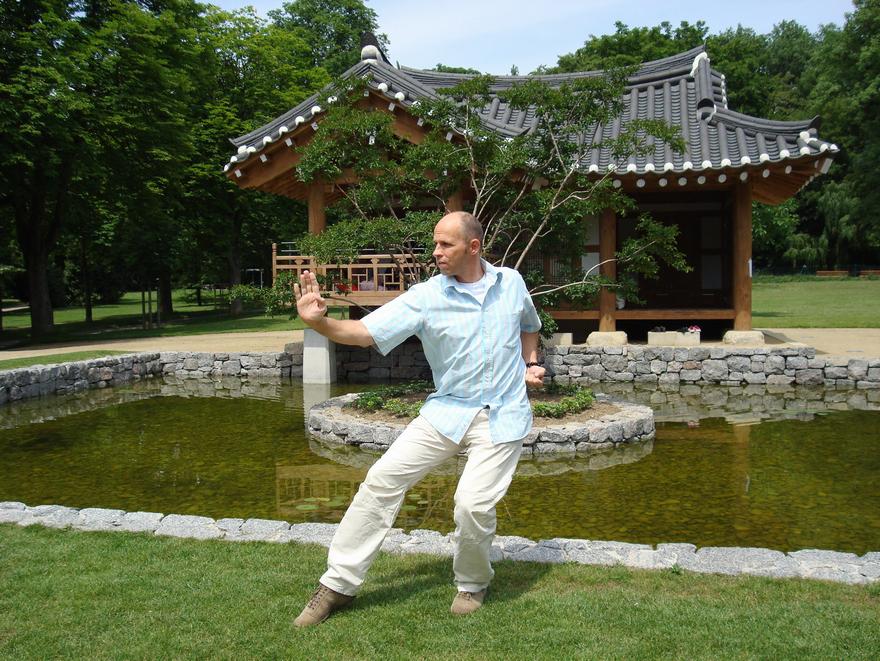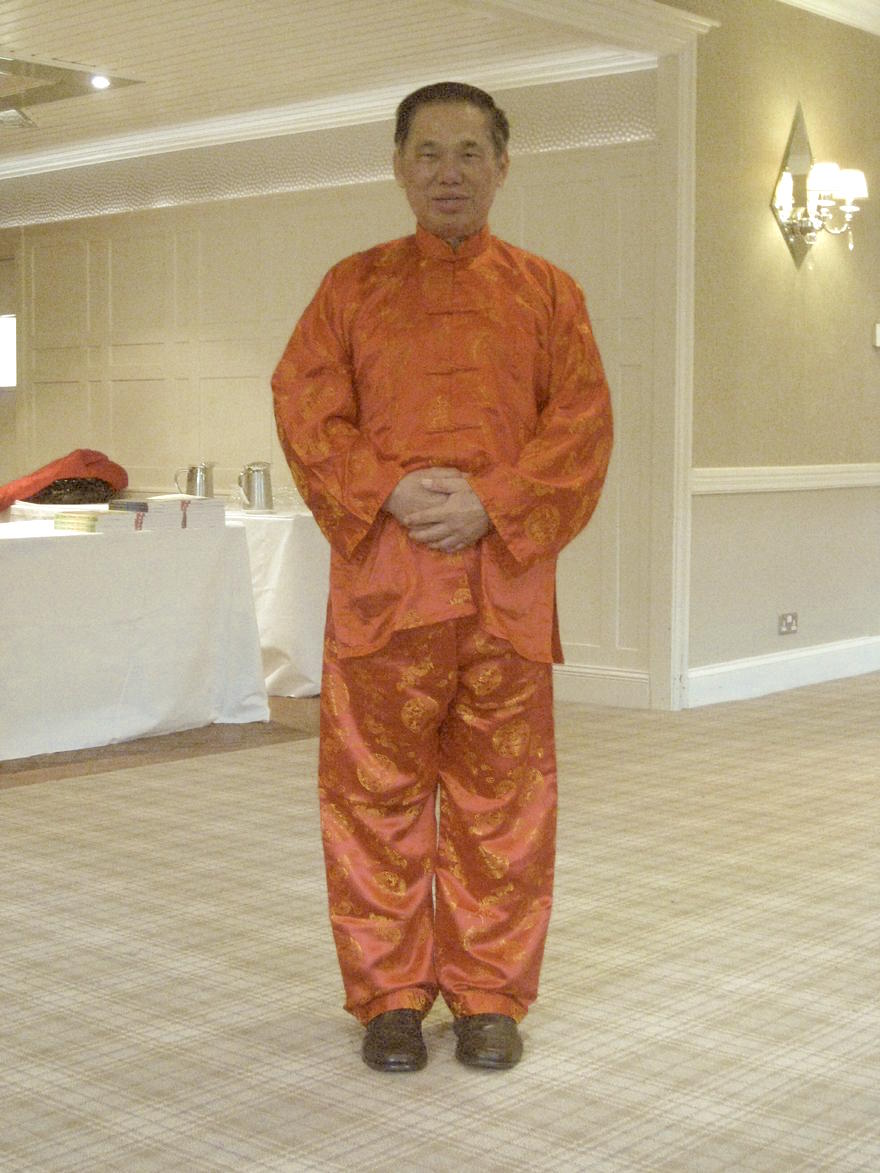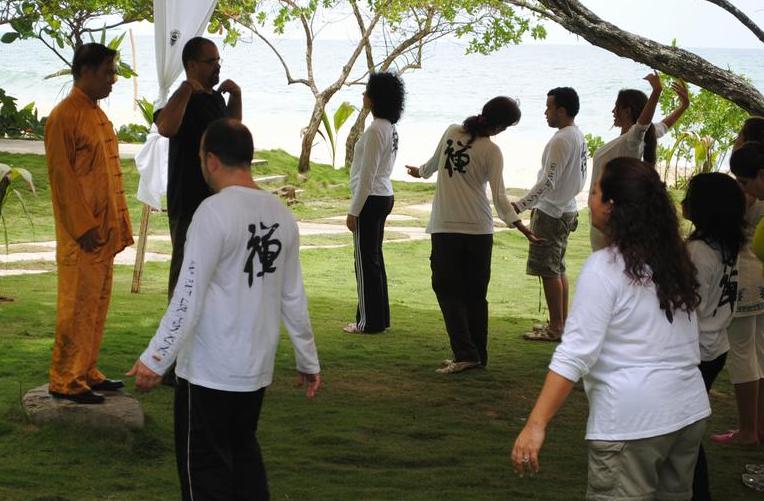SELECTION OF QUESTIONS AND ANSWERS
DECEMBER 2012 PART 3

The main aim of practicing kungfu is to enrich our life
Question 1
I want to study Kung-Fu very seriously, and I want to become your pupil, and to master all subtleties of the art.
— Gusky, Russia
Answer
If you wish to learn Shaolin Kungfu, you should first learn from Sifu Kai Uwe who is from Germany but flies to and teaches in Moscow periodically. If you wish to learn Taijiquan, which is also kungfu, you can learn from Sifu Julio Volunskaya who lives in Moscow. Please see List of Certified Instructors for details of their contact particulars.
If you live too far from Moscow, you can learn Shaolin Kungfu or Taijiquan from a local instructor first. If a local instructor is not available, you can learn some Shaolin Kungfu or Taijiquan forms from my book, The Art of Shaolin Kung Fu or the Complete Book of Tai Chi Chuan. Learning from books is not as effective as learning from a live instructor, but my books are a good alternative if live instructors are not available.
When you have some foundation in Shaolin Kungfu or Taijiquan, you can attend my Intensive Shaolin Kungfu Course or Intensive Taijiquan Course. You should continue to practice on your own after the course. If there are opportunities you should attend further courses by me.
It is never easy to learn good genuine kungfu, though debased kungfu which is more of gymnastics or dance is plentiful. But if you are really serious, it can be done. Students nowadays are luckier than people in the past when learning kungfu was a rare opportunity.
However, many people may say that learning kungfu is their life-long ambition, but they don't make any effort to do so.
Question 2
I liked the psychology of Kung-Fu very much. Sooner or later I will earn money for a trip to the Shaolin Monastery.
Answer
I do not know what you mean by the psychology of kungfu.
But the most important reason why a person learns kungfu, or any art, is to enrich his life and the lives of other people.
The Shaolin Monastery is a wonderful place to visit. But you are unlikely to learn traditional Shaolin Kungfu in the Shaolin Monastery today because it is no longer taught there.
What is taught often by modern Shaolin monks in numerous schools around the Shaolin Monastery is modern wushu. Modern wushu is a magnificent art, practiced all over China as well as in many places in the world. Its training makes you acrobatic, and provide opportunities to compete in competitions and win trophies.
But modern wushu is different from traditional Shaolin Kungfu, though the outward forms are the same. The three hallmarks of traditional Shaolin Kungfu for which it is famous, namely internal force, combat efficiency and spiritual cultivation, are not practiced in modern wushu.

Sifu Kai Uwe Jettkandt
Question 3
I earn good money, but I have bought a car for my mother on credit.
Answer
It is wonderful that you have bought a car for your mother. It is one of the best things you have done with your money.
Question 4
I want to live completely in a monastery for studying Kung fu and Chi-Kung. I think I can be a good pupil. How is it possible to become your high-grade pupil, living in a monastery? What is it necessary to do?
Answer
You need not live in a monastery to practice good kungfu. What you need is a good teacher willing to teach you. More importantly you must be a good student.
You practice kungfu to enrich every aspect of your life. You should not enslave yourself to kungfu.
In other words, by practicing kungfu, whatever you do, you will do better. When you wake up, you feel fresh and full of life. When you work, you produce better result in shorter time. When you come home, you spend quality time with your family and friends. When you go to bed at night, you are satisfied that you have lived your day well.
By practicing kungfu, you should not cut yourself off from your friends and family, have no time for your work and hobbies, spend all your time on kungfu and nothing else. In this way you enslave yourself.

The technique of dan tian breathing can be employed for the skills of Abdominal Breathing or of Cosmic Breathing
Question 5
I recently began practicing abdominal breathing from Sifu Wong's amazing book The Art of Chi Kung. Now I understand that he doesn't really teach abdominal breathing any more but instead he teaches Dan Tien breathing. Are the instructions for Dan Tien breathing in print anywhere?
— Dudley, USA
Answer
The instructions for dan tian breathing, or breathing from the abdominal energy field, are not in print in my books for self learning. The reason is that people practicing from books may learn the technique correctly, yet they will not derive benefits from dan tian breathing. Worse, they may derive harmful effects.
Many people may be puzzled at the above statements, and some may think it is an excuse for not revealing the secret of dan tian breathing, or a device to entice them to learn personally from me. These conclusions are, of course, incorrect. Indeed, we in Shaolin Wahnam are well known for being very generous in sharing secrets.
The following history of the changing names of our courses from Abdominal Breathing to Dan Tian Breathing, and now to Cosmic Breathing will be beneficial to those interested in chi kung.
I first learned the technique of abdominal breathing from my senior Wuzuquan classmates in Sifu Chee Kim Thong's school. Although I learned the technique correctly in a few minutes, it took me more than a few years to experience some benefits when I learned from Sifu Ho Fatt Nam.
Why did I take such a long time to derive benefits from abdominal breathing though I could perform the technique correctly. It was because, like most people, I did not know the difference between technique and skill, and that it was skill not technique that was crucial in getting benefits from the practice. In other words, even when I practiced the technique correctly but did not have the required skill, I would not get the purported benefits.
It was later when I learned the Small Universe from my sifu, Sifu Ho Fatt Nam, that I became more proficient in abdominal breathing. It was much later when I had taught chi kung to the public that I began to appreciate the difference between techniques and skills.
My teaching of chi kung tremendously improved both my techniques and skills as well as their underlying philosophy in various chi kung arts. Hence I was able to successfully teach Abdominal Breathing in just one day in regional courses. This attainment was unbelievable, and possibly unprecedented. It is understandable that many people do not believe that this is true. Not only I could teach both the skills and techniques of abdominal breathing, but more importantly my students obtained the purported benefits.
I continued to improve my teaching methodology tremendously. Not only the techniques of abdominal breathing became simpler, the benefits also increased manifold. To differentiate the two modes of techniques, I called the improved techniques Dan Tian Breathing.
At first the results of abdominal breathing and dan tian breathing were similar, the difference was in the techniques. Hence, for a time, the two terms, abdominal breathing and dan tian breathing, were often used interchangeably.
But eventually the results became different. In abdominal breathing the energy flows from the nose to the dan tian, and from the dan tian out of the mouth. The flow is vertical. In dan tian breathing the energy flows in from the Cosmos to the dan tian, and flows out from the dan tian to the Cosmos. The practitioner pulsates with the Cosmos.
Thus, I started to use the term Cosmic Breathing instead of Dan Tian Breathing, because the technique of dan tian breathing can be used to attain the benefits obtained from both the course of Abdominal Breathing and the course of Cosmic Breathing. Similarly, the technique of reverse breathing, which is "opposite" of abdominal breathing, can also be used to attain the benefits of Abdominal Breathing and Cosmic Breathing. (Other people not familiar with the arts taught in our school may find the explanation here confusing.)
The main aim of Abdominal Breathing is to develop a lot of internal force for health, vitality, longevity and combat efficiency. Besides also attaining the benefits of Abdominal Breathing, the main aim of Cosmic Breathing is to expand into the Cosmos to experience spiritual joy and freedom.
Question 6
How would a patient choose the best way to cure his illness?
— Felix, Spain
Answer
A patient should first consult his doctor.
For diseases where cures are available, like infectious diseases caused by bacteria, Western medical treatment is speedier and usually better.
Even for viral infection, and Western treatment cannot kill viruses, it is better to consult a Western doctor first. By taking antibiotics prescribed by a doctor that kill other micro-organisms, the patient's own defence system will be more efficient in overcoming the viral infection.
But when diseases are considered incurable from the Western medical paradigm, like organic diseases such as cancer and cardiovascular disorders, and psychiatric diseases such as depression and phobia, consulting a chi kung healer or a chi kung teacher is wise, as in the chi kung paradigm every illness can be overcome.
In the chi kung paradigm, the cause of any disease is energy blockage. Good health is natural, and is maintained by energy flowing to all organs and systems to enable them to do their natural work. If the energy flow is blocked, the respective organs or systems fail their normal functions, resulting in illness. When the blockage is cleared by energy flow, the natural functions are restored and the person recovers his good health.
There are two main approaches in energy flow -- thematic and holistic. In thematic energy flow, the patient directs the energy to flow to specific regions where the illness is. In holistic energy flow, the patient lets the energy to flow wherever it wants. It is a natural characteristic of energy to flow from high energy areas to low energy areas. Low energy areas are where the illness is as there is insufficient energy there for life processes to function normally. Usually the patient uses both approaches to overcome his illness.
He will assure as well as speed up his recovery if during the energy flow or at the end of his chi kung session he gently thinks that his illness will soon be overcome.

Energy flow in a chi kung class in Venezeula
Question 7
Is there research done to show chi kung is effective in curing so-called incurable diseases like cancer and cardiovascular problems?
Answer
Yes, there has been a lot of research done in China as well as many other places to show that chi kung is effective in curing so-called incurable diseases like cancer and cardiovascular problems. One can readily find such research papers if he searches in the internet.
In our school itself, many students with so-called incurable diseases have overcome them by practicing chi kung.
Question 8
If chi kung is effective in curing so-called incurable diseases, why aren't these patients come to chi kung?
Answer
This is an illuminating and legitimate question. The main reason is that information is not perfect.
Most people, including those suffering from so-called incurable diseases, do not know of this fact that chi kung can overcome these diseases.
Even when they know, they may not believe it is true.
Another important reason is that only genuine high-level chi kung can overcome so-called incurable diseases. Genuine high-level chi kung is rare.
More than 80% of chi kung practiced today is actually not chi kung; it is gentle physical exercise. The forms are the same, but practitioners perform these forms not as chi kung but as gentle physical exercise, and most of them may not even know the difference.
A parallel is found in Taijiquan. Taijiquan Is actually an internal martial art, but most Taiji practitioners today perform the Taijiquan forms not as an internal martial art but as an external dance. There is nothing internal, and nothing martial in what they practice.
When one practices a gentle physical exercise -- and that is what more than 80% of those who innocently think they practice chi kung do -- he cannot overcome illness.
LINKS
Selected Reading
- To Prove that Qi is Real and that Qigong is Not a Fake Healing Art
- Courage and Confidence in Teaching and Healing
- A Pattern for All Occasions
- Er Shi Quan or Twenty Punches
- Beautiful Country
